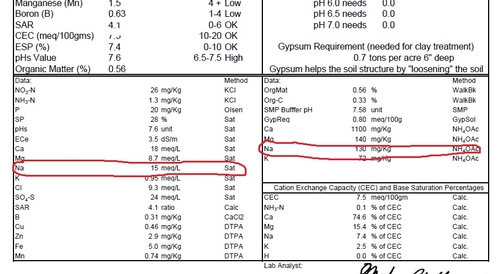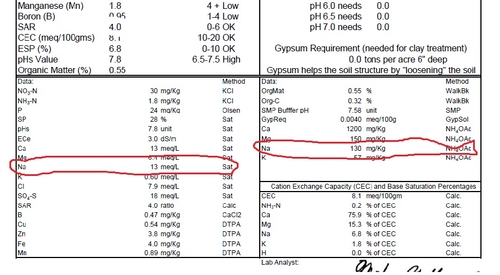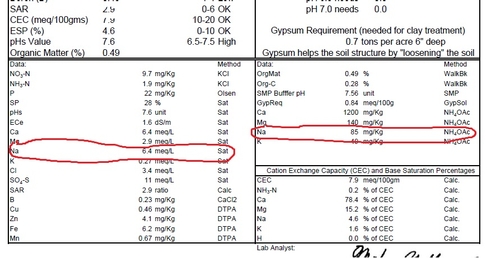I am writing this in response to the questions at yesterday's mineral nutrition meeting regarding the two different outputs on laboratory soil analyses for sodium. Pretty tough gig standing in front of about 70 of your peers and not having the answer right away, but so it goes.
The questions pertained to the difference between a reading of “exchangeable sodium” measured in parts per million (ppm) or mg/kg, and sodium measured in meq/l (milliequivalents per litre) from saturated paste. The photos below of three different soil samples tested by a local analysis provider shows the “exchangeable sodium” output in mg/kg (also read as ppm) on the right, and sodium measured in meq/L from saturated paste on the left.
Let's summarize a recent communication of mine with Dr. Tim Hartz from UC Davis in order to understand what these mean to us:
1. The extract from NH4OAc method is the "exchangeable sodium" a minority of which is considered to be ‘active' -meaning what the plant root could encounter- in the soil solution. The "exchangeable sodium percentage" (ESP) for coastal soils is around 2.5% of the base saturation on average, and one shouldn't run into trouble until this percentage of exchangeable sodium gets in the range of 7 or 8%.
2. To see what is ‘active' and what the plant root is facing, one needs to look at the saturated paste analysis which measures soluble sodium. Numbers around 3 or 4 meq/liter are good and don't indicate a problem; numbers much higher than these figures would be point to a sodium problem.
Let's go to the analyses below from some soils and practice with these numbers for exchangeable sodium and saturated paste extracts measuring soluble sodium.
Attached Images:

Sample # 1: Saturation extract of Na measured as 15 meq/L, and the amount of 'exchangeable sodium' of 130 mg/kg (ppm) is 7.4% of the total base saturation (box at bottom right) , well above the 2.5% which is OK for coastal soils . The strawberry plants from this area of the field were dead.

Sample #2: Saturation extract of Na measured as 13 meq/L, and the amount of 'exchangeable sodium' of 130 mg/kg is 6.8% of the total base saturation (box at bottom right) , well above the 2.5% which is OK for coastal soils. The strawberry plants from this part of the field were dying.

Sample #3: Saturation extract of Na measured as 6.4 meq/L, and the amount of 'exchangeable sodium' of 85 mg/kg (ppm) is 4.6% (box at bottom right) of the base saturation; seems OK. The plants from this area of the field were apparently all right.